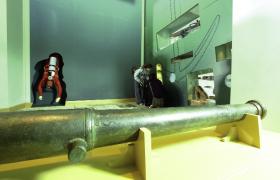Museum Eye
Published in 18th–19th - Century History, 20th-century / Contemporary History, Early Modern History (1500–1700), General, Issue 6 (Nov/Dec 2009), Reviews, Volume 17The Tower Museum, Derry
O’Doherty’s Tower, Union Hall Place
www.derrycity.gov.uk/museums, +44 (0)28 71372411
October–May, Tues.–Sat. 10am–5pm
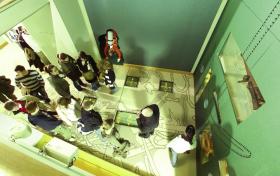
Visitors to the La Trinidad Valencera exhibition (above), on the Spanish Armada ship that sank in nearby Kinnegoe Bay in 1588, including the ship’s wheel (middle) and one of its cannon (bottom).
The city of Derry could be described as a monument of the Plantation of Ulster. It owes its existence and its famous never-breached walls to the Honourable the Irish Society, that association of London guilds which undertook to colonise, or plant, the city and county for James I and which added ‘London’ to the ancient nomenclature. The walls are now open to the public and a major tourist attraction. From an architectural, historical and sightseeing perspective they are worth a walk around. Information panels at different points give the story of the siege of 1688–9 and explain the significance of buildings below or abutting the walls. They also afford great vantage points from which to view the countryside and the rest of the city—in particular the Bogside, with its famous ‘Free Derry’ gable wall.
Ironically, the city built as a Protestant stronghold and which was a bulwark of unionism for centuries is now mainly a Catholic-nationalist place in terms of population and local government. Many view the building of O’Doherty’s Tower as a means through which the nationalist population laid claim to the city and asserted its more ancient Gaelic heritage. The tower is built on the site of an O’Doherty fortified house of the sixteenth century and in style pays homage to the traditional Irish tower-house. Whatever about its outside appearance, the tower has a state-of-the-art museum, run by the city’s Heritage and Museum Service, which was redesigned in recent years to house the artefacts of La Trinidad Valencera, the Spanish Armada ship that sank in nearby Kinnegoe Bay in 1588. This exhibition takes up four of the museum’s five floors.
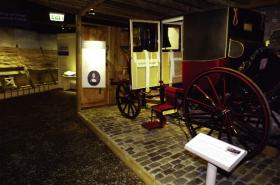
The coach in which, in November 1761, Andrew Knox MP and his daughter Mary Anne were held up by John McNaughton, Mary Anne’s lover. His intention was to shoot the father and elope with the daughter but in the confusion he shot dead his sweetheart, for which he was later hanged—but only on the second attempt. He was known ever after as ‘Half-hanged McNaughton’.
The ‘Story of Derry’ now occupies the ground floor of the museum. It consists of a number of galleries running off a main hall. The visitor can start with the first, ‘Origins’, and follow each in turn to the twentieth century, or access each gallery separately from the hall. All this is very clever and reflects the equally clever layout of each gallery, which makes good use of video screens, life-size manikins, actual artefacts and reproductions to convey the story of the city from its Neolithic settlement, through its foundation as a monastery, to the Plantation and beyond. The motion-activated video screens can be a bit unnerving at first, but you get used to them.
The beginning of the historic period is marked by a display on the famous Broighter Hoard, found in County Derry, with its iconic golden ship, and a recreation of the Cross of St Martin from Iona, a reminder of Derry’s connections with Colmcille and his international significance. Of course there is much about the local saint, his works and his foundation of a monastery in the place that became known as Doire Cholmcille. Derry’s significant place in Gaelic Ireland right up to the sixteenth century is well illustrated and a reminder that it was not a wilderness before the English arrived to build a fort here in their war against Hugh O’Neill and his ally Hugh O’Donnell. The two Hughs were ultimately defeated, but local resistance continued in the form of Cahir O’Doherty, who attacked and set fire to the English town in 1608. His sword is one of the objects on display here, along with a manikin of Richard Bartlett and copies of his maps, which were essential in planning the Plantation.
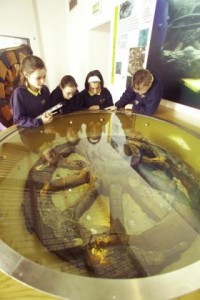 A large wall and a couple of stonemasons introduce the section on the Plantation. As you approach the wall, the screen above it becomes active and a short film explains the reason why Derry and its county were granted to the Honourable the Irish Society. The narrator discusses the consequences of that for the native Irish and, interestingly, puts Londonderry in the context of similar colonies in America. The growth of the city from there on is explained through display cases, artefacts and reproductions.
A large wall and a couple of stonemasons introduce the section on the Plantation. As you approach the wall, the screen above it becomes active and a short film explains the reason why Derry and its county were granted to the Honourable the Irish Society. The narrator discusses the consequences of that for the native Irish and, interestingly, puts Londonderry in the context of similar colonies in America. The growth of the city from there on is explained through display cases, artefacts and reproductions.
There wasn’t much peace for the Planters in either Derry or the rest of Ulster. The 1641 rising saw a widespread attack on them, and Derry was besieged by the rebels in 1649. It successfully resisted that siege, as it did the more famous one 40 years later. For understandable reasons a lot of space is given to the Jacobite siege, and it is worth spending time in this gallery with its diorama, a tableau of the famous closing of the gate against King James’s forces by the apprentices, an effigy of Lundy like that burned by the present-day Apprentice Boys, and other artefacts on display. The original state sword of the Irish Society, the charter granted to the city by Charles II and the mace presented to the corporation by William and Mary all attest to Derry’s pivotal role in this period of conquest and colonisation as a Protestant stronghold, which of course was what the Plantation was about.
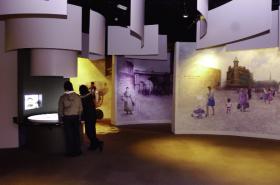
Orientation gallery in the ‘Story of Derry’, which now occupies the ground floor of the museum.
Derry continued to be central to events in Ireland right up to the recent Troubles and the Peace Process. Subsequent galleries take the visitor through the centuries, where the political history is balanced by the social. Derry’s prosperity as a port in the eighteenth and nineteenth centuries is recounted, while displays on the original Ordnance Survey, Amelia Earhart’s flight across the Atlantic, local theatres and so on show that there is more to the history of the city than sieges and political turmoil.
The tone of the museum throughout is neutral and balanced. Events are set in context, eschewing a ‘heroes and villains’ approach. This comes across in the final area showing a short film on Derry’s recent history in which ordinary people talk about the Civil Rights movement, the Troubles and the peace. Everyone knows that this city has a divided history, as its two names—Derry and Londonderry—attest. The museum does a good job in tackling that divided history, and the Heritage and Museum Service has big plans to commemorate the Plantation over the next five years with a major programme of events and projects to raise awareness and improve understanding of this pivotal event in Derry’s history. If balanced or neutral history is too anodyne for your tastes, however, there are many other opportunities to get the full-on version from one side or the other. Not far from the Tower Museum is one run by the Apprentice Boys of Derry about the city’s heroic defenders, linked to a guided tour of the walls entitled ‘Heroes of the Siege’. On the other hand, there are historical walking tours that also take in the Bogside and Free Derry, giving a very different version of events. Take your pick.
